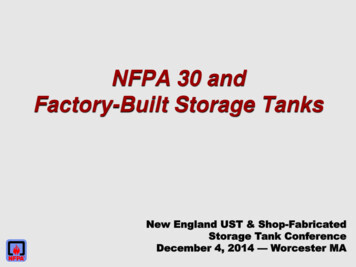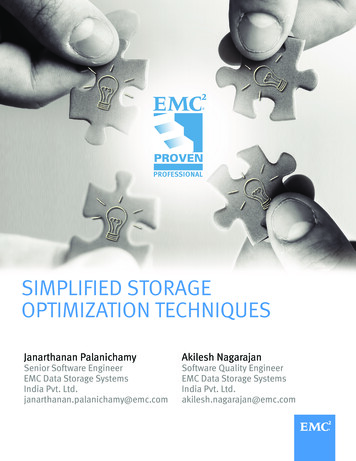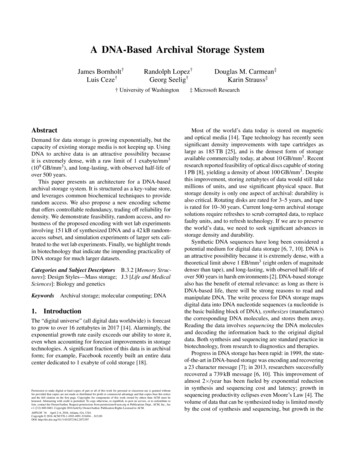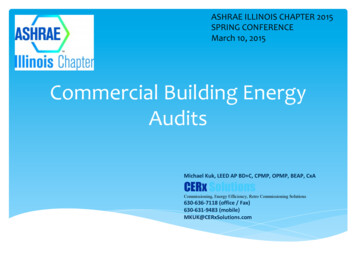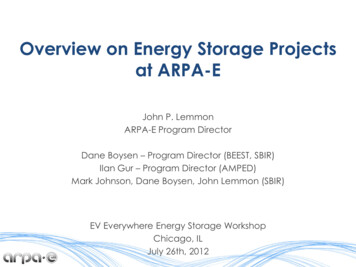
Transcription
Overview on Energy Storage Projectsat ARPA-EJohn P. LemmonARPA-E Program DirectorDane Boysen – Program Director (BEEST, SBIR)Ilan Gur – Program Director (AMPED)Mark Johnson, Dane Boysen, John Lemmon (SBIR)EV Everywhere Energy Storage WorkshopChicago, ILJuly 26th, 2012
ARPA-E’s creation and launchingInnovation based on science andengineering will be primary driverof our future prosperity & security2012FY2012 Budget( 275 Appropriated)2011FY2011 Budget( 180M Appropriated)2009American Recoveryand Reinvestment Act( 400M Appropriated)2007America COMPETESActPresident Obama launchesARPA-E at National Academieson April 27, 20092006Rising Above theGathering Storm(National Academies)2
ARPA-E’s mission is to overcome the high-risktechnological barriers facing energy technologiesReduce EnergyImportsTo enhance the economic and energy security of the U.S.To ensure U.S. technological lead in developing anddeploying advanced energy technologiesReduce EnergyRelated EmissionsImprove EnergyEfficiency(A) promotingrevolutionaryadvances infundamentalsciences(B) translatingscientificdiscoveries intotechnologicalinnovations(C) acceleratingtransformationaltechnologicaladvances inareas thatindustry by itselfis not likely toundertake3
Why should you care?2010 U.S. PetroleumConsumption by Sector2010 U.S. TransportationConsumption by ModeTransportation drives U.S. dependence on imported oilElectric vehicles could reduce or eliminate need for imported oil4
The ARPA-E ApproachTransformational & disruptive technologiesthat lead to new learning curvestransformationalcost / performanceSteam-powered Cugnot (1769)Benz Motorwagen (1885)transformational & disruptiveexisting learning curvetippingpointnew learning curveFord Model T(1914)time5
DOE Coordinated Battery R&D EffortsBasic Energy SciencesAdvanced Research Projects Agency-EnergyEERE-Vehicle Technologies ProgramMaterials Research structure and interfaces measurementCell Research & Development mechanisms analyses new chemistries user facilities electrodes electrolytes microstructure0123Battery System Development design and construction life testing cost reduction safety and durability456Technology Readiness Level (TRL)6
ARPA-E’s first open FOA resulted 37 projects acrossa wide variety technology areasWater3,700 ConceptPapersWaste ects6projectsVBR Power Systems5projectsBuilding Efficiency360 FullApplications3projectsBiomassEnergyFOA 15projects4projectsRenewablePower37 Selectedprojects for nCapture5projectsSolar Fuels7
BEEST Primary Technical TargetBatteries for Electrical Energy Storage in TransportationBEEST Primary Technical TargetsID NoMetricDavid DanielsonAssistant Secretary, EERESystemCellUnits1.1Specific Energy Density (at C/3)200400Wh/kg1.2Volumetric Energy Density (at C/3)300600Wh/L1.3System Cost 250 /kWhState-of-the-ArtSystem: 120 Wh/kg, 250 Wh/L, 600 /kWhCell:220 Wh/kg, 500 Wh/L8
What is new about our approach?Today ARPA-EGasolinepracticaltheoreticalLi-airLi-SAdv ll energy density (Wh/kg)4000High risk-high reward batteries chemistries with potential forhigher energy density and lower cost9
BEEST Program – Dane Boysen PDBatteries for Electrical Energy Storage for TransportationObjectives Cost-competitive with conventional vehicles 30% of today’s cost at 2-5x energy storage 300-500% longer battery life range1.2.3.4.5.6.7.8.9.10.24M-MITApplied Materials, IncMissouri University of Science & TechnologyPellion Technologies, Inc.PolyPlus Battery CompanyRecapping, Inc.ReVolt Technology LLCSion Power CorporationStanford UniversityPlanar Energy2-5x performance 1/3 priceTerm:Projects:Investment:2010-201310 33.6M10
AMPED Program – Ilan Gur PDAdvanced Management and Protection of Energystorage DevicesProgram Status: Proposals Under ReviewWhat is the problem we want to solve? 75% of total system weight,volume, cost spent on safety,reliability, and lifetimeassuranceLifetime of battery systems isstill lifetime of vehicleSafety still major liabilityCharge-rate limited due to riskof degradation/failureReliability risks prohibitsecondary and dual useBalanceof SystemPhysical protectionThermal managementCharge balancingState monitoringEtc.8 kWhcellsAdditional capacitybuffer: safety/lifetimeassurance8 kWhcellsCapacity needed topropel vehicle for 40mile rangeState-of-the-Art 40-mile Plug-in EV**Approximate Specs
Many opportunities for disruptive innovation atthe system level.1. Sensingprovidesindirectstateinformationwith lowspatial andtemporalresolutionSystem Design2. Simple equiv. circuitmodels, heuristicallyvalidated, limited accuracy3. Simple rule-based controlimposes “static” andconservative constraints4. Systemdesignsare simple:passivebalancing,modularmonitoringand control
ARPA-E’s AMPED PROGRAMApprox. 30 million for disruptiveinnovation in batterymanagement Currently in review stageSensingModelingControlsSystemsProgram Director: Dr. Ilan Gur(Matl Sci, UC Berkeley)13
SBIR – High Energy Density Electrical Energy Storage ForTransportation. PD Dane BoysenProgram Status: Proposals Under ReviewWhat ARPA-E is looking for:Non-lithium based batterychemistriesMetal-air battery approachesNovel battery architecturesNew electrolytesMetal-sulfur battery approachesAdvanced lithium-ion basedbattery systemsOther novel electrical energystorage approaches14
ARPA-E’s Open FOA 2 – full applications under reviewConcept PapersFullApplicationsEnergy Storage ?Selectedprojects15
Thank You16
BEEST Secondary Technical TargetBEEST Secondary Technical TargetsID No MetricTarget2.1Specific Power Density400 W/kg (system)800 W/kg (cell)[80% DOD, 30s]2.2Volumetric Power Density600 W/L (system)1200 W/L (cell)[80% DOD, 30s]2.3Cycle Life1000 cycles at 80% DOD2.4Round Trip Efficiency (RTE)80% at C/32.5Temperature Tolerance-30 C to 65 C with 20% degradation inenergy/power density; cycle life, RTE vs 25 C2.6Self Discharge 15%/month2.7SafetyTolerant to abusive charging/damage2.8Calendar Life10 years17
Rising Above the Gathering Storm (National Academies) 2007 . America COMPETES Act . President Obama launches ARPA-E at National Academies on April 27, 2009 . Innovation based on science and engineering will be primary driver of our future prosperity & security . 2009 . American Recovery and R






